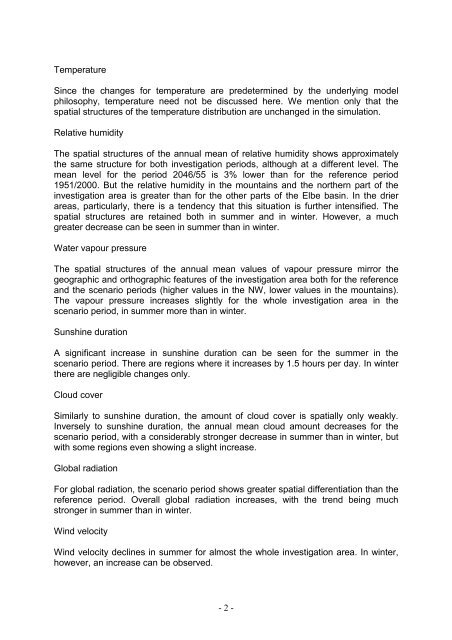2.2 SIMULATION RESULTS OF THE REGIONAL CLIMATE MODEL ...
2.2 SIMULATION RESULTS OF THE REGIONAL CLIMATE MODEL ...
2.2 SIMULATION RESULTS OF THE REGIONAL CLIMATE MODEL ...
Create successful ePaper yourself
Turn your PDF publications into a flip-book with our unique Google optimized e-Paper software.
Temperature<br />
Since the changes for temperature are predetermined by the underlying model<br />
philosophy, temperature need not be discussed here. We mention only that the<br />
spatial structures of the temperature distribution are unchanged in the simulation.<br />
Relative humidity<br />
The spatial structures of the annual mean of relative humidity shows approximately<br />
the same structure for both investigation periods, although at a different level. The<br />
mean level for the period 2046/55 is 3% lower than for the reference period<br />
1951/2000. But the relative humidity in the mountains and the northern part of the<br />
investigation area is greater than for the other parts of the Elbe basin. In the drier<br />
areas, particularly, there is a tendency that this situation is further intensified. The<br />
spatial structures are retained both in summer and in winter. However, a much<br />
greater decrease can be seen in summer than in winter.<br />
Water vapour pressure<br />
The spatial structures of the annual mean values of vapour pressure mirror the<br />
geographic and orthographic features of the investigation area both for the reference<br />
and the scenario periods (higher values in the NW, lower values in the mountains).<br />
The vapour pressure increases slightly for the whole investigation area in the<br />
scenario period, in summer more than in winter.<br />
Sunshine duration<br />
A significant increase in sunshine duration can be seen for the summer in the<br />
scenario period. There are regions where it increases by 1.5 hours per day. In winter<br />
there are negligible changes only.<br />
Cloud cover<br />
Similarly to sunshine duration, the amount of cloud cover is spatially only weakly.<br />
Inversely to sunshine duration, the annual mean cloud amount decreases for the<br />
scenario period, with a considerably stronger decrease in summer than in winter, but<br />
with some regions even showing a slight increase.<br />
Global radiation<br />
For global radiation, the scenario period shows greater spatial differentiation than the<br />
reference period. Overall global radiation increases, with the trend being much<br />
stronger in summer than in winter.<br />
Wind velocity<br />
Wind velocity declines in summer for almost the whole investigation area. In winter,<br />
however, an increase can be observed.<br />
- 2 -
















